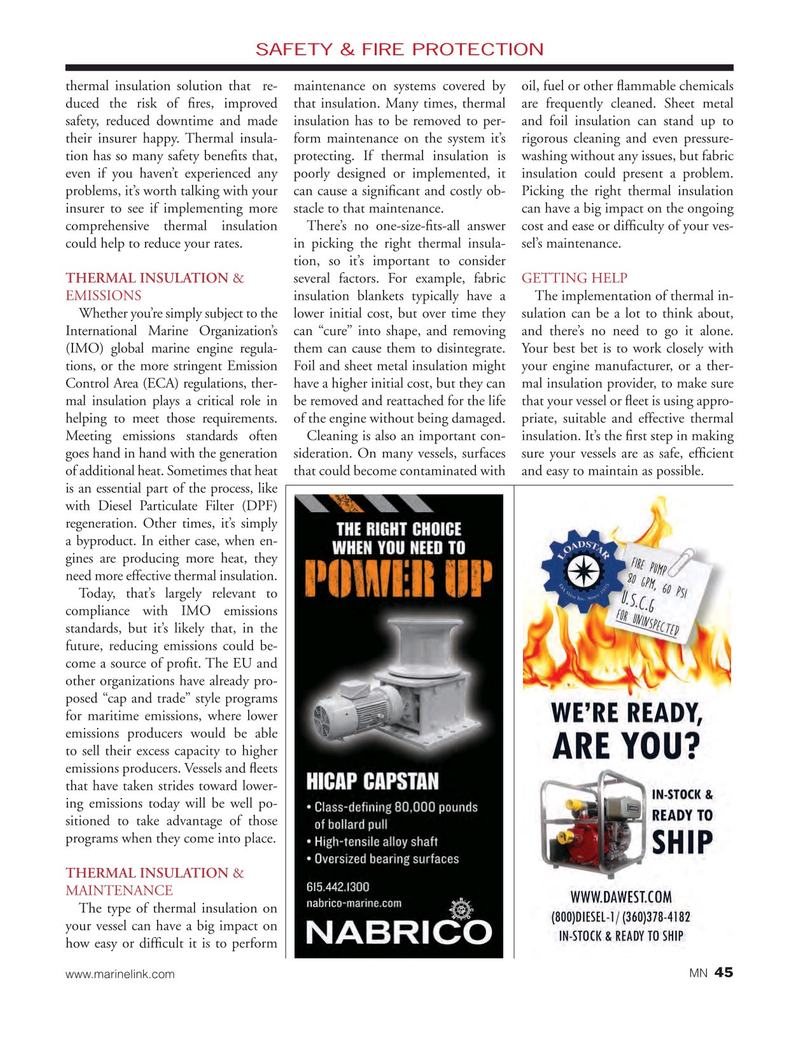
Page 45: of Marine News Magazine (September 2016)
Offshore Annual
Read this page in Pdf, Flash or Html5 edition of September 2016 Marine News Magazine
SAFETY & FIRE PROTECTION thermal insulation solution that re- maintenance on systems covered by oil, fuel or other ? ammable chemicals duced the risk of ? res, improved that insulation. Many times, thermal are frequently cleaned. Sheet metal safety, reduced downtime and made insulation has to be removed to per- and foil insulation can stand up to their insurer happy. Thermal insula- form maintenance on the system it’s rigorous cleaning and even pressure- tion has so many safety bene? ts that, protecting. If thermal insulation is washing without any issues, but fabric even if you haven’t experienced any poorly designed or implemented, it insulation could present a problem. problems, it’s worth talking with your can cause a signi? cant and costly ob- Picking the right thermal insulation insurer to see if implementing more stacle to that maintenance. can have a big impact on the ongoing comprehensive thermal insulation There’s no one-size-? ts-all answer cost and ease or dif? culty of your ves- could help to reduce your rates. in picking the right thermal insula- sel’s maintenance. tion, so it’s important to consider
THERMAL INSULATION & several factors. For example, fabric GETTING HELP
EMISSIONS insulation blankets typically have a The implementation of thermal in-
Whether you’re simply subject to the lower initial cost, but over time they sulation can be a lot to think about,
International Marine Organization’s can “cure” into shape, and removing and there’s no need to go it alone. (IMO) global marine engine regula- them can cause them to disintegrate. Your best bet is to work closely with tions, or the more stringent Emission Foil and sheet metal insulation might your engine manufacturer, or a ther-
Control Area (ECA) regulations, ther- have a higher initial cost, but they can mal insulation provider, to make sure mal insulation plays a critical role in be removed and reattached for the life that your vessel or ? eet is using appro- helping to meet those requirements. of the engine without being damaged. priate, suitable and effective thermal
Meeting emissions standards often Cleaning is also an important con- insulation. It’s the ? rst step in making goes hand in hand with the generation sideration. On many vessels, surfaces sure your vessels are as safe, ef? cient of additional heat. Sometimes that heat that could become contaminated with and easy to maintain as possible.
is an essential part of the process, like with Diesel Particulate Filter (DPF) regeneration. Other times, it’s simply a byproduct. In either case, when en- gines are producing more heat, they need more effective thermal insulation.
Today, that’s largely relevant to compliance with IMO emissions standards, but it’s likely that, in the future, reducing emissions could be- come a source of pro? t. The EU and other organizations have already pro- posed “cap and trade” style programs for maritime emissions, where lower emissions producers would be able to sell their excess capacity to higher emissions producers. Vessels and ? eets that have taken strides toward lower- ing emissions today will be well po- sitioned to take advantage of those programs when they come into place.
THERMAL INSULATION &
MAINTENANCE
The type of thermal insulation on your vessel can have a big impact on how easy or dif? cult it is to perform 45 www.marinelink.com MN
MN Sept16 Layout 32-49.indd 45 8/22/2016 10:15:21 AM

 44
44

 46
46
